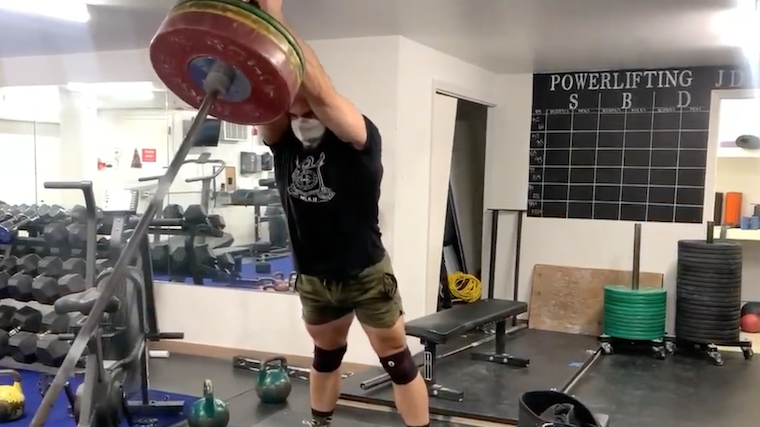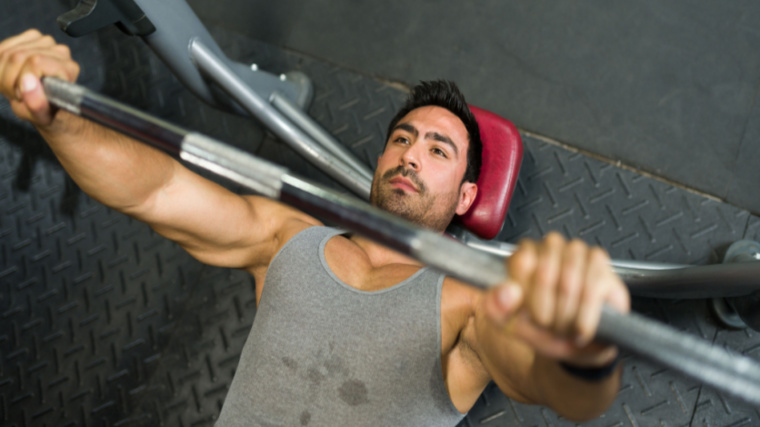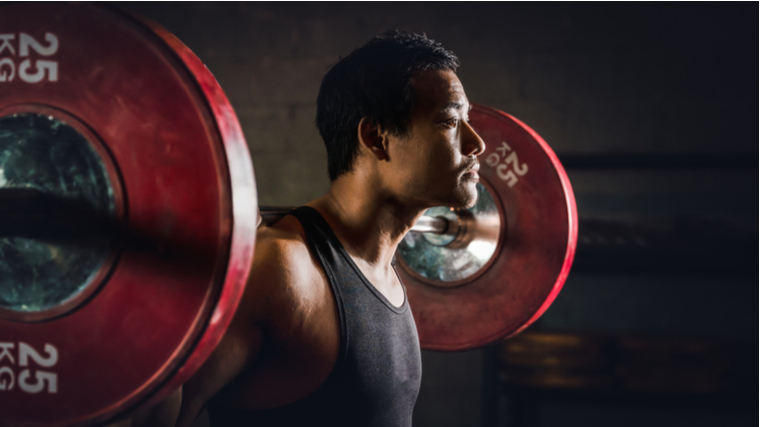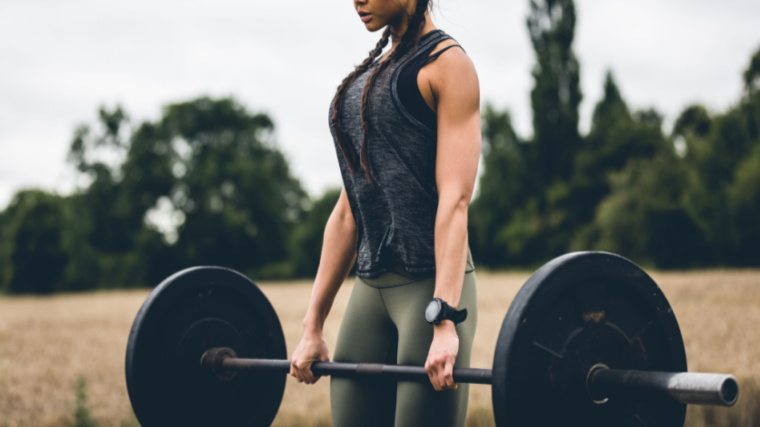Originally Posted At: https://breakingmuscle.com/feed/rss
Perhaps you’ve seen a lifter pressing, twisting, or rowing a barbell by rotating it on end. Appropriately named, these landmine exercises produce lethally effective workouts. Landmine training is performed in settings from Division 1 college weight rooms to bodybuilding gyms to injury rehab clinics.

The barbell is used for lever-based resistance — one end pivots on the floor or in a purpose-built sleeve as the lifter moves the loaded end through space. Make no mistake, this is not flashy “training for the ‘Gram” or some gross misuse of equipment.
The landmine provides opportunities for exercises with characteristics distinct from traditional free-weight training. The best part? Landmines offer versatility to train the entire body along with multiple components of fitness. Here, you’ll find the best landmine workouts for building serious upper and lower-body muscle, along with elite-level conditioning.
Best Landmine Workouts
Benefits of Landmine Training
Landmine training (literally) leverages a simple piece of equipment for a wide range of exercises. Traditional barbell training is already versatile, so why use your barbell as a landmine?
Landmines provide a more predictable bar path than a barbell moving freely through space. In motor learning — the scientific field that studies movement and skill acquisition — this predictable bar path represents a “constraint.” That is, the landmine is constrained to move along an arced path.
This constraint helps a lifter to master the form of technical multi-joint lifts, such as the presses, rows, and cleans used in the workouts below. It also promotes more consistent movement performance. Constant movements, when performed under load, stimulate the target muscles exceptionally effectively. The result is a fast-learning curve and predictable gains in strength and size.
The arced bar path also alters exercise form compared to barbell training. Landmine presses keep the shoulder out of end-range flexion, an area of common restriction. Landmine rows encourage ideal shoulder blade movement “down and back.” Landmine squats virtually ensure we sit back into our hips with an upright trunk position, which demands textbook form.
Landmine exercises also appear to stress our joints differently than traditional free weight lifts. (1) Altogether, the landmine may be helpful if you have banged up knees or shoulders. Set your landmine and get ready for a different angle on barbell training.
Best Landmine Workout for Upper Body Muscle
The upper body landmine workout below is like a multi-course meal — a feast for your muscles. The meat and potatoes are compound exercises followed by isolation movements.
Compound exercises, or those involving multiple joints, are efficient because they train many muscle groups simultaneously. They’re also very effective for building strength because they allow you to move heavier loads than exercises training a single joint in isolation.
Upper body compound exercises are broadly categorized as either “pushes” or “pulls.” Pushing exercises involve driving a resistance away from the body and training the chest, shoulders, and triceps. Pulling exercises involve drawing a resistance toward the body. These exercises train the back and biceps.
The compound exercises in this workout are structured as a series of push/pull supersets for efficiency. The final two movements are isolation exercises like a satisfying dessert after the main course. They train the glamour muscles that stretch our sleeves and broaden our frame.
Upper Body Training, One Arm at a Time
Due to the lever-based resistance of the landmine, your typical free weight loads and percentages will not be appropriate. It would be best to determine appropriate working weights that result in “hard” sets within the recommended repetition range.
To determine working weight for each exercise, perform two or more progressively heavier “work up” sets. Once you land on a weight that challenges you within the set rep range, stick with that load for your working sets.
Half-Kneeling Landmine Press
- How to Do it: Assume a “half-kneeling” position with the working-side knee down. Hold the bar above your shoulder, brace your torso, and drive the bar up and forward along the natural arc of the landmine. Lower to the starting position.
- Sets and Reps: 3 x 6-10 per arm.
- Rest time: No rest before moving to the next exercise.
Meadows Row
- How to Do it: Stand perpendicular to the landmine. Hold the bar sleeve with an overhand grip and brace your non-working arm on your thigh. Lift the bar by driving your elbow out as you squeeze your shoulder blade toward your spine. Lower to full extension until you feel an intense stretch behind your shoulder. Be sure to load the bar with small diameter plates (five, 10, or 25-pound) to allow an extended range of motion.
- Sets and Reps: 3 x 8-12 per arm.
- Rest time: Rest two to three minutes before repeating the previous exercise.
Standing Landmine Press
- How to Do it: Face the landmine with a staggered stance, keeping your working side leg behind you. Press the bar forward and up until your elbow reaches full extension. Lower with control.
- Sets and Reps: 3 x 8-12 per arm.
- Rest time: No rest before moving to the next exercise.
Landmine Row
- How to Do it: Stand parallel to the barbell. Hinge forward at the hips and grip the barbell just before the sleeve. Pull your shoulder and arm back to row the weight toward the outside of your hip. Lower with control.
- Sets and Reps: 3 x 8-12 per arm.
- Rest time: Rest two to three minutes before repeating the previous exercise.
Landmine Lateral Raise
- How to Do it: Stand with the end of the barbell just in front of your working side hip, quarter turned toward the landmine. Lift by pushing the bar forward and out until your wrist is higher than shoulder. Lower with control.
- Sets and Reps: 3 x 12-16 per arm
- Rest time: No rest before moving to the next exercise.
Landmine Concentration Curl
- How to Do it: Drop into a wide-stance quarter squat and brace your upper arm against your inner thigh. Grab the end of the bar sleeve. Without moving your upper arm, curl the landmine barbell. Notice how the bar path forces you to keep your palm turned up and out as you curl. This enhances biceps stimulus. (2)(3) Lower with control.
- Sets and Reps: 3 x 8-12 per arm.
- Rest time:Rest 90 seconds to two minutes before repeating the previous exercise.
Best Landmine Workout for Lower Body Muscle
Wheels, lower extremities, jets, getaway sticks — whatever you call them, most people want strong, muscular legs.
Like the upper body, the basic compound movements of the lower body can be categorized as push and pull or, more commonly, squats and deadlifts, respectively. Squats and squat-derivatives train the glutes, quadriceps, and calf muscles. Deadlifts and deadlift-derivatives train the hamstrings and also hit the glutes.
Leg-Building Landmine Workout
This workout combines heavy, double-legged exercises with single-leg lifts to promote athleticism, and it finishes with a loaded mobility exercise for the commonly-neglected inner thigh muscles.
The landmine provides a small amount of balance assistance, which may allow single-leg variations of squats and deadlifts to be loaded heavier than free-weight single-leg versions.
To ensure adequate recovery, the lower body landmine exercises are structured as straight sets. Take two to three-minute rests to ensure intensity is maintained for maximum strength gains. (4)
Landmine Squat
- How to Do it: Cradle the end of the barbell atop your sternum with your arms pulled in toward your ribs. To account for the arced path of the bar, place your feet farther from the plates so that your body is inclined forward in the top position. Squat down as far as your mobility allows, and return to standing.
- Sets and Reps: 3 x 6-10
- Rest time: Rest two to three minutes between sets.
Modified Single-Leg Landmine Romanian Deadlift
- How to Do it: Unlike the standard single-leg landmine Romanian deadlift, which is performed facing the landmine, (5) the modified version provides more stability, which lets you lift more weight. Stand perpendicular to the landmine. Hold the sleeve palm-down with your inside hand. Hinge forward at your hips and allow your inside leg to travel behind you, while that foot rises into the air. Keep a slight bend in your standing knee and descend until you feel a strong sense of tension in your hamstring. Return to standing and repeat.
- Sets and Reps: 3 x 6-10 per leg.
- Rest time: Rest 2 to 3 minutes between sets.
Landmine Hack Squat
- How to Do it: Ensure you landmine base is secure and will not slide. Face away from the landmine and rest the sleeve on your upper trapezius, just inside the point of the shoulder. Position your feet well in front of your body. Keep your feet flat as you descend into a deep squat, reaching your hamstrings to your calves if possible. Drive up and back to the starting position. On your next set, rack the landmine on your opposite shoulder.
- Sets and Reps: 2 x 12-16
- Rest time: Rest two to three minutes between sets.
Landmine Cossack Squat
- How to Do it: Face the landmine with a wide stance and hold the landmine in front of your sternum. Sit down and back, sinking into your right hip while allowing your left foot to pivot onto the heel. Push through your right leg to return to center. Perform all repetitions to the right, then repeat to the left.
- Sets and Reps: 2 x 8-10 per side.
- Rest time: Rest two to three minutes between sets.
Landmine Workout for Conditioning
Barbell complexes are commonly used for metabolic conditioning. Complexes are sequences of lifts performed in continuous succession. The lifter finishes all reps of one lift before moving on to the next, using the same piece of equipment and the same weight for all movements.
Complexes can be designed to tax every energy system — the phosphagen system provides quick bursts of power. The glycolytic system becomes prominent as the complex drags on for more than the first few reps. Finally, if you string multiple complexes together in a fashion popularized by many notorious CrossFit workouts, the aerobic system helps you recover.
Every Two-Minute On the Two-Minute Landmine Complex
The landmine is a wonderful tool for complexes. The workout below uses repeated landmine complexes to promote metabolic conditioning. For simplicity, a time-based rest strategy provides most athletes an approximate 1:1 work to rest ratio. Every two minutes, you will start a new complex and complete it as quickly as you can.
- How to Do it: Place a moderate amount of weight on the landmine. First perform the Landmine Hang Clean & Jerk — Stand perpendicular to the bar and hold the sleeve in the hang position (palm down with your hand near your hip). Extend your hips, knees, and ankles as you shrug and pull the bar along its natural arc. As the bar is in motion, pivot to face the landmine and receive the bar with your other hand. Perform a split jerk by dropping down and immediately driving back up with your legs as you extend your elbow and switch your footing. Control the bar back to the hang position with both hands.The next movement is the classic standing Landmine Rotation — Hold the bar with both arms outstretched above you. Lower the bar to the left, allowing your hips to rotate and your feet to pivot. Rotate the landmine back up and across to the right, again allowing your feet and hips to move smoothly.The third and final exercise in this complex is a Landmine Push Press — This exercise begins similar to a shallow landmine squat with a ballistic concentric (“up”) phase. Transfer the energy from your leg drive into both arms as you press the bar up and forward. Repeat the process for for each repetition.
- Sets and Reps: One “set” of the complex consists of 3 reps of each movement — 3 per side landmine hang clean & jerk, 3 rotations in each direction, and 3 push presses. Perform one set every two minutes for a total of 12 to 16 minutes.
- Rest time: Perform one full set and rest the remainder of the two minute block. This rest strategy is a variation on the much more popular EMOM (Every Minute on the Minute), but “E2MO2M” doesn’t have the same ring.
How to Warm-Up for Landmine Workouts
Before you detonate these workouts, perform a high-quality warm-up to ensure your body is primed for performance. Options for effective warm-ups are innumerable, but for those who can’t spare the bandwidth to conjure one up, here’s a simple plan.
Start with five or six minutes of low intensity aerobic exercise (jump rope, bike, or cardio method of choice), then grab a light resistance band and move through the following sequence:
Landmine Workout Warm-Up
- Deep Squat with Trunk Rotations: Drop down into a deep squat. Keep your chest up and reach toward the ground with both arms between your legs. Use one arm to “pry” your same-side thigh outward as you reach up with the other arm. As you reach, keep your eyes on your overhead palm by rotating and extending your trunk. Repeat with the other hand. Perform 8 rotations in each direction, alternating sides each repetition.
- Backstep Lunge to Hip Flexor Stretch: Take a large step backwards and lower your knee to the ground. Squeeze your rear-leg glute muscles to feel a stretch in the front of the hip or thigh. If you are unable to achieve a stretch, attempt to tuck your pelvis under your body by bringing your belt buckle toward your chin. Hold the position momentarily. Return to standing and repeat with the opposite leg. Perform 8 reps per leg.
- Plank to Pike: Assume a tall plank or “top of the push-up position” supporting your body on your palms and forefeet. Move into a pike position by pushing forward with your hands and driving your hips back and up, Keep your spine, arms, and legs straight. Return to the plank position. Perform 8 reps.
- Dynamic Hug: Wrap a light resistance band around your back just below your shoulder blades. Stand with arms outreached straight ahead at shoulder-height. Reach forward in a “hugging” motion. Imagine you are wrapping your arms around a gigantic tree to maximize the space between your arms as you reach your hands together. Reverse the movement, allowing your shoulder blades to move toward your spine as you open your arms. Perform 8 repetitions.
- Band Pull-Apart: Hold the resistance band straight ahead with your arms in front of your shoulders. Stretch the band by pulling your arms apart without bending your elbows. Initiate the movement by squeezing your shoulder blades toward your spine. When your hands are sideways in-line with your shoulders, return to the starting position. Perform 8 repetitions.
An Angled Approach to New Gains
The landmine is a fun and versatile tool for training all major muscle groups. Landmine lifts promote a balanced physique while hammering the core, and may actually result in superior gains in on-field or on-court athleticism. (6) Bookmark these landmine workouts and blast your next high-quality training session.
References
- Collins, K. S., Klawitter, L. A., Waldera, R. W., Mahoney, S. J., & Christensen, B. K. (2021). Differences in muscle activity and kinetics between the goblet squat and landmine squat in men and women. Journal of Strength and Conditioning Research, 35(10), 2661-2668.
- Murray, W. M., Delp, S. L., Buchanan, T. S. (1995). Variation of muscle moment arms with elbow and forearm position. Journal of Biomechanics, 28(5), 513-525.
- Kleiber, T., Kunz, L., & Disselhorst-Klug, C. (2015). Muscular coordination of biceps brachii and brachioradialis in elbow flexion with respect to hand position. Frontiers in Physiology, 6, 215.
- Schoenfeld, B. J., Pope, Z. K., Benik, F. M., et al. (2016). Longer interset rest periods enhance muscle strength and hypertrophy in resistance-trained men. Journal of Strength and Conditioning Research, 30(7), 1805-1812.
- Weaver, A. N., & Kerksick, C. M. (2017). Implementing landmine single-leg Romanian deadlift into an athlete’s training program. Strength & Conditioning Journal, 39(1), 85-90.
- Zweifel, M. (2017). Importance of horizontally loaded movements to sports performance. Strength and Conditioning Journal, 39(1), 21-26.
Featured Image: Merrick Lincoln, DPT, CSCS / YouTube
The post The Best Landmine Workouts for More Muscle and Better Conditioning appeared first on Breaking Muscle.













 Apple cider vinegar is purported to have a number of impressive benefits. Chief among these is that apple cider vinegar can help you lose weight—allegedly. As I wrote previously, much of the hype around
Apple cider vinegar is purported to have a number of impressive benefits. Chief among these is that apple cider vinegar can help you lose weight—allegedly. As I wrote previously, much of the hype around 
 For now classes are 6pm and 640pm at 2840 Wildwood st in the Boise Cloggers studio.
Book your class NOW!
click this ==>
For now classes are 6pm and 640pm at 2840 Wildwood st in the Boise Cloggers studio.
Book your class NOW!
click this ==>








